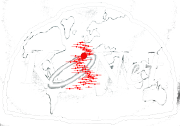 |
The KOI network
Welcome to the only network in the world conformed by middle-sized telescopes getting ready to observe the Kepler field and continue characterizing exoplanets. The network has two main advantages: while the longitudinal coverage allows continuous monitoring of the sky, the large apertures of the involved telescopes are required to observe the 13-15 mag Kepler stars. Observations will begin this March, 2014.
Most of the already existent
follow-up networks are conformed by small-sized telescopes. Since
Kepler objects are generally faint, large amounts of exposure time are
required to achieve precise photometric data. Furthermore, most of the
KOIs reported to have large-amplitude TTVs produce shallow primary
transits. Therefore, small telescopes can potentially produce primary
transit light curves that are poorly sampled, being the detectability
secured only for deep transits. All together, small telescopes can not
follow-up most of the KOIs. In comparison to other networks, ours
presents two fundamental advantages:
- Large collecting areas: This will allow to follow-up
KOIs that are faint (~13-16 KP) and present shallow primary transit
events, minimizing observational biases. It is important to keep in
mind that the TTVs have been already detected, and that the TTV
amplitude is of the order of minutes. Therefore, detecting such
offsets will not be challenging.
- Large longitudinal coverage: most of the KOIs are
conformed by planets in large orbits. Since the transit duration grows
linearly with the orbital period, for some of the KOIs the transit
duration is longer than the astronomical night in a given site.
Therefore, more than one site is required to fully observe the eclipse
event. The configuration indicated with red circles in Fig. 2 will
allow 24 hours of continuous observations. The participation of
Hawaiian and Indian telescopes is crucial.